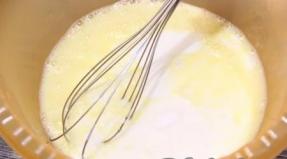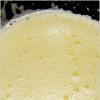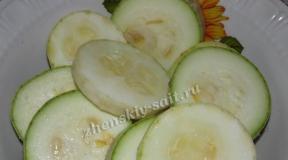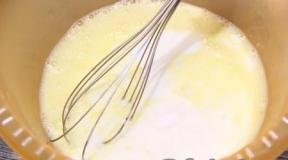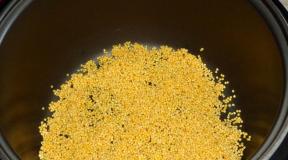Slizkin A., Safronov S. How many legs does a crab have? How many legs does a crab have and are all of them legs? How many legs does a crab have?
Morphology and anatomy
Morphology and anatomy. The structural segments of the external structure of decapod crustaceans form two distinct body sections: the cephalothorax and abdomen. Based on their appearance, decapods are divided into two main groups: representatives of one have a spindle-shaped, crustacean body shape (these include crayfish, shrimp, lobsters, and lobsters, which are generally known in school textbooks), and the other has a special body shape called crab-shaped (Makarov , 1938). Representatives of the latter group are various types of crabs, including those living in the Kamchatka waters.
Each type of crustacean has paired legs adapted for different purposes: walking and swimming, searching and capturing food, defense and attack, breathing, mating and other specialized functions. All decapods have five pairs of legs extending from the thoracic segments. They serve for movement, on the basis of which the entire order received the name decapod crustaceans.
The so-called “true” crabs of the suborder have the most compact form Brachyura, the main feature of which is the symmetrical structure of the body; four pairs of thoracic legs are involved in their movement, and the fifth pair is armed with claws of the same size. Crabs of this group most often have a compact abdomen; males bear paired copulatory organs. This group of crabs has the largest number of genera and species, however, in the seas of the northern part of the Pacific Ocean, and in the Kamchatka waters in particular, the group of false crabs of the suborder is more diverse Anomura. To the crabs of the group Anomura include the most famous Far Eastern lithodid crabs and hermit crabs. These decapods have common ancestors and, accordingly, have some of the same characteristics - an asymmetrical body structure (the right claw is larger than the left) and only three pairs of walking legs, unlike the crabs of the family Brachyura(Ivanov, Monchadsky et al., 1983; Jensen, 1995).
The cephalothorax of crabs is formed by segments of the head and thoracic parts of the body fused together. It is believed that historically the crab-shaped body shape was formed precisely in the coastal strip of the seas. This is supported by the fact that taxonomically different groups have a similar body Decapoda real crabs (Brachyura), which include the Far Eastern commercial snow crabs (Fig. 1, A) and hairy crabs (Fig. 1, B), and false (Anomura) including Kamchatka (Fig. 1, C), prickly (Fig. 1, D), etc.
The body of crabs is covered with a dense covering of chitinous cuticle, which consists of lipids, proteins and nitrogenous organic matter, chitin. The hardening of the cuticle in crabs is due to the “impregnation” of chitin with calcium carbonate. The chitinous cover forms the exoskeleton, which protects the animal from the adverse effects of various environmental factors and serves to maintain a certain body shape. The external shell created the problem for crustaceans of the need to periodically shed the old shell, while ensuring spasmodic body growth. As molting approaches, the skin epithelium of crabs secretes a new soft cuticle, a significant amount of calcium carbonate enters the blood from the old cuticle (shell), and the shell becomes fragile. During molting, the old cuticle peels off, the animal begins to actively absorb water from the external environment, its size increases, under the influence of which the old cover breaks and the animal leaves it. Consequently, the amount of growth of a crustacean is limited by the size of the previously formed new integumentary tissue (cuticle), and the growth occurs immediately at the moment of molting. The molting process is accompanied by a significant restructuring of metabolic processes and the state of the body, and requires large energy costs.

The three anterior thoracic segments of crabs are fused with the head, and their limbs are transformed into jaws and tactile organs and antennae (Fig. 2). The cephalothorax is covered on top with a carapace, the width, length and height of which, along with other features, are of primary importance in taxonomy (Fig. 3).

In biological analysis, as a rule, the carapace is measured, the most resistant part of the crabs body when damaged. The width of the carapace is the main indicator of the commercial size of the crab. The surface of the carapace is more or less clearly divided into four regions: gastric, cardiac and two gill (see Fig. 4).

The anterior part of the carapace in many species transforms into a protrusion called the rostrum, or beak, which is important in identifying the type of crab. The presence of various grooves, tubercles, spines, depressions and protrusions on the cephalothorax can also be used to judge the species of the crab. In addition, for species diagnostics of crabs, the structural features of the antennae are used: antennules and antennae (in crabs they are relatively short), as well as the structure of the anterior pair of oral appendages - mandibles - the main organ for grinding food. Each mandible consists of a body bearing a chewing ridge and a palp that cleans the jaws, although the latter is absent in some genera (Ivanov, Monchadsky et al., 1983) (see).
Walking legs, or peripods, usually consist of segments and movable joints, each segment has its own name (Fig. 5).

The first segment, counting from the place of attachment of the leg to the body, is called a coxopodite, the second is a basipodite, the third is an ischiopodite, the fourth is a meropodite, the fifth is a carpopodite, the sixth is a propodite and the seventh is a dactylopodite, or claw. In most species of decapod crustaceans, the claw, together with the outgrowth of the penultimate segment, forms a true claw. There is also technological terminology by which miners and processors call crab leg segments differently. Thus, technologists call coxo-, basi and ischiopodite “rosette”, followed by “thick segment”, “neck” (“knuckle”), “claw” or “thin segment” and “claw” (Table 1). When examining crabs externally, it is not always possible to see the fifth pair of legs. In lithodid crabs, the last pair of legs is greatly modified and hidden under the shell, where it performs the function of cleaning the gills. The front pair of legs is armed with claws and is called clawed.

The abdomen of males and females differ in shape: in females it is semicircular, convex (Fig. 6) and on the lower side there are abdominal legs - pleopods, which is due to the functional characteristics of the organ (fertilized eggs are attached to them); in females it also serves as a brood chamber. Male lithodid crabs lack abdominal legs, while true crabs (Brachyura) the front abdominal legs have a pair (in snow crabs) or two pairs (in hairy crabs) of limbs that have turned into copulatory organs.

Crabs have compound eyes of the facet type, located on stalks, due to which the field of vision significantly expands. At the moment of danger, the eyes hide in the orbital sockets (Fig. 7). The eye includes up to three thousand or more ocelli, or facets. Each facet perceives only those rays that fall perpendicular to its surface. The whole image of an object is synthesized by all facets of the eye. He sees a crab nearby. It orients itself in space primarily with the help of smell and touch (Dogel, 1975; Ivanov, Monchadsky et al., 1983).

The internal organs of crabs, grouped in a certain way, form a structure characteristic of higher crustaceans. A description of the structure and functional features of the internal organs of decapods is given below.
Belongs to the class Crustaceans. The lure crab is a highly organized semi-terrestrial crustacean of small size. A special feature of this animal is its giant right claw. While moving, the alluring crab makes certain movements with its large claw, as if luring individuals of the opposite sex to itself and vice versa, scaring away other crustacean animals. That's why the crab got its name. The lure crab also has regenerative abilities. A claw that falls off for some reason grows back. In some cases, the new claw of the beckoning crab grows larger than the previous claw.
Body structure of a beckoning crab
The body of the alluring crab, like that of other representatives of this species of crustaceans, consists of a cephalothorax and a reduced abdomen. The whole body consists of segments. The segmented head, consisting of two pairs of small antennae and stalked eyes, is smoothly connected by a segmented abdomen. The head consists of three pairs of jaws and three pairs of jaws. The chest consists of five pairs of walking legs, of which the first pair of legs is claw-shaped. The head and chest of the beckoning crab are covered with carapace. The carapace is the shell that covers the body of the crab. Only males have a huge claw. In females, both the right and left claws have the same structure.
Animal characteristics:
Dimensions: body length without limbs 1.5-2.5 cm, with claws 5-10 cm.
Color: The body of the beckoning crab comes in different colors, mostly dark grey, dark red and black. Large claw and limbs: red-yellow-white and other gradually changing colors.
Feeding crab
The digestive system of the lure crab consists of three parts: the middle - endodermal section, the anterior section and the posterior rectum. The anterior section consists of the esophagus and stomach. The lure crab feeds mainly on small crustaceans, algae, aquatic plants and detritus; it can also consume large quantities of soil.
Reproduction and habitat of the beckoning crab
Alluring crabs are dioecious animals. The female genital openings are located on the sixth thoracic segment, located near the third pair of walking legs. The male genital openings are located on the eighth thoracic segment, located at the fifth pair of walking legs. In males, the holes are tubes that are filled with germ cells during the breeding season. During mating, the male introduces these cells into the genital openings of the female. The female lure crab mounts the eggs on her abdominal legs and holds them there until hatching.
Alluring crabs are widespread in tropical waters, mainly on the islands of the Pacific and Indian Oceans.
Full or partial reprinting of the article is PROHIBITED; if the use of the material is agreed upon with its author and site administration, a link to the source is required.
From a zoological point of view, crabs and crayfish belong to the same species. These animals have their own categories of definition and their own hierarchy. And among them there are also giants, which is what king crab, which, despite the name, is considered one of the
Appearance of Kamchatka crab
The appearance of the king crab is indeed very similar to others, but still the animal belongs to the craboids and is distinguished primarily by its reduced fifth pair of legs.
This is one of the largest representatives of its species, belonging to the Lithodidae family. Size adult Kamchatka crab the male reaches 25 cm in cephalothorax width and 150 cm in leg span, with a weight of 7.5 kg. Females are smaller, weighing about 4.3 kg.
The body of the crab consists of a cephalothorax, located under a common shell, and an abdomen. The abdomen, or abdomen, is folded under the chest. The shell in the area of the heart and stomach is equipped with sharp spines, of which there are 6 above the heart and 11 above the stomach.

Pictured is Kamchatka crab
Thus, it protects the soft body of the crayfish, and at the same time serves as a support for the muscles, since the animal does not have a skeleton. There are gills on the sides of the shell.
On the front of the shell there are protruding growths that protect the eyes. The entire nerve cord is located on the lower side of the body. The stomach is located at the head of the body, and the heart at the back.
Kamchatka crab has five pairs limbs, four of which are walking, and the fifth is used for cleaning the gills. Kamchatka crab claws each has its own purpose - with the right it breaks hard shells and crushes hedgehogs, while with the left it cuts softer food.

The female can be distinguished by the more round structure of the abdomen, which in the male is almost triangular. The color of the crab's body and legs is red-brown above and yellowish below. There are purple spots on the sides. Some individuals are brighter colored, appearance Kamchatka crab can be assessed by photo.
Habitat of the Kamchatka crab
This large animal lives in many seas. The main range is in the Far Eastern region and the northern regions of the seas washing it. This is how the crab lives in the Sea of Japan, Okhotsk, and Bering. Inhabits Bristol Bay. The range is concentrated near the Shantar and Kuril Islands, Sakhalin and most of all in Kamchatka.
Kamchatka crab was induced into the Barents Sea. This process was long and complex, starting theoretically back in 1932. Only in 1960 was it possible for the first time to transport adult individuals from the Far East.

Between 1961 and 1969, the bulk of crabs were imported, mainly using air transport. And in 1974, crab was caught for the first time in the Barents Sea. Since 1977, these animals began to be caught off the coast of Norway.
At the moment, the population has grown greatly, the crab has spread along the coast of Norway to the southwest, as well as north to Spitsbergen. In 2006, the crab population in the Barents Sea was estimated at 100 million individuals. The crab lives at a depth of 5 to 250 meters, on a flat sandy or muddy bottom.
Lifestyle of the Kamchatka crab
The Kamchatka crab leads a fairly active lifestyle; it constantly migrates. But his path is always built along the same route. Travel speed is up to 1.8 km/h. Crabs walk forward or sideways. They do not know how to burrow into the ground.

In the photo there is a blue Kamchatka crab
During cold periods, the crab goes deep to the bottom, dropping to 200-270 meters. With the arrival of heat, it rises to the warm upper layers of water. Females and juveniles live in shallow water, while males move a little deeper, where there is more food.
Once a year, an adult Kamchatka crab molts, shedding its old shell. By the time the old cover disappears, a new, still soft, shell is already growing under it. The molting process takes about three days, during which the crab does not like to be seen and hides in holes and rock crevices. “Naked” females are guarded by males.
Molting for the “stronger sex” takes place later, around May, when the water temperature reaches 2-7 C⁰. In addition to the chitinous cover of the animal, the outer membranes of the heart, stomach, esophagus and tendons also change. Thus, the animal is almost completely renewed every year and gains new mass.

Young animals molt frequently - up to 12 times in the first year of life, 6-7 times in the second year and then only twice. After reaching the age of nine years, crabs become adults and molt only once a year, and old 13-year-old individuals only molt once every two years.
Nutrition of Kamchatka crab
The Kamchatka crab feeds on bottom inhabitants: sea, various, starfish, small fish, plankton, arrows, etc. The Kamchatka crab is an almost omnivorous predator.
Young individuals (fingerlings) feed on hydroids. Using the right claw, the crab extracts soft meat from hard shells and shells, and eats food with the left claw.
Commercial species of crabs
In the Far Eastern seas there are many species of crabs available for catching. In those parts you can buy Kamchatka crab or anyone else.

The Baird's snow crab is a smaller species and can sometimes mate and produce hybrids with the Opilio snow crab. These species weigh up to approximately 1 kg. and have a caracapus size of about 15 cm. The red snow crab lives in the Sea of Japan. This is a small animal on average 10-15 cm. Named for its bright scarlet color.
Prices on Kamchatka crab vary, you can buy a whole crab, live or frozen. There is an opportunity to purchase phalanges of Kamchatka crab, claws - in shell and without, meat and various ready-made dishes from it. The cost at catch sites is significantly lower than when taking into account delivery to the regions. The price of a live crab is about 10,000 rubles.
Kamchatka crab meat It is very valuable for the whole body due to the presence of vitamins and microelements in it. It is good for vision, strengthening the cardiovascular system and generally improving the condition of the body.

Reproduction and life expectancy of the Kamchatka crab
During spring migration, females carry eggs with embryos on their abdominal legs, and their ovaries contain a new portion of unfertilized eggs. On the way to shallow water, larvae hatch from the outer eggs.
Then the females and males meet, and molting occurs. The male helps the female get rid of the old shell, and when this happens, he attaches a ribbon of spermatophores to her walking legs, after which he goes to the depths to feed.
The female spawns eggs and fluid to activate spermatophores. The number of eggs reaches 300 thousand. The eggs are attached to the female's abdominal legs, which she constantly moves, washing the eggs with fresh water. During the warm season, the eggs develop, but freeze in the winter and growth is activated again only in the spring, during the period of migration and warming of water.

The photo shows the claws of a Kamchatka crab
The hatched larvae do not at all resemble crabs - they are oblong creatures with a long abdomen, without legs. For about two months, the larvae are carried along the seas by currents, during which time they manage to molt four times.
Then they sink to the bottom, molt for the fifth time and only then acquire legs, a shell, and their abdomen becomes much shorter. After another 20 days, the larva molts again and this continues throughout the summer and autumn.
Animals grow quickly, becoming more and more similar to their parents with each molt. For the first 5-7 years, crabs live in one place and only then begin to migrate. At the eighth year of life, female crabs become sexually mature, and at 10 years old, males are also ready to reproduce. Kamchatka crab lives for a very long time - about 15-20 years.
Crabs belong to the phylum arthropods, class Crustaceans, subclass Higher Crustaceans, order Decapoda crustaceans. These animals are found almost everywhere on Earth. Crabs have five pairs of legs, with the first pair long ago transformed into powerful claws. The size of crabs varies depending on the species. Typically, a crab's shell is between 2 and 30 cm wide.
Crabs are close relatives of crayfish. At first glance, they differ from cancer in the absence of a “tail” - an abdomen. In fact, crabs have an abdomen, but it is very small and tucked under the chest: a long abdomen is a hindrance when walking! Crabs could not become purely terrestrial animals; their life is closely connected with water, only there they can reproduce.
There are about four hundred different species of crabs, living in the oceans, with rare cases on land. Almost all crabs live in water and breathe through gills, just like fish. Some crabs swim on the surface of the sea, others move along the bottom, and some live under rocks and on the seashore.
Species native to the Indian and Pacific Oceans use the sea anemone as a weapon for hunting. They place it on one of the claws and paralyze the prey “by someone else’s hands” - with the help of its burning tentacles!
Decapods are very active animals. Crawling is carried out with the help of four pairs of hind limbs, which are located in front of the abdomen in crabs, which gives their gait a characteristic feature: they do not move straight, but in what is called a “barrel”.
An ordinary grass crab runs at a speed of 1 m/s, and a land ghost crab rushes on outstretched legs so fast that it manages to catch even small birds. Swimming crabs move sideways, with the second to fourth pairs of thoracic legs making 630-780 strokes per minute, and the last pair working even more intensely.
The small abdomen makes up the main part of its body, completely protected by a thick shell. The shell is the hard shell that covers the crab's body. It can be quadrangular, square, triangular or round in shape. The shell is the crab's main defense, but it does not grow with the animal, and when it becomes too tight, the crab sheds it.
When one shell is replaced by another, the crab becomes completely defenseless and is forced to hide among the stones until the new shell is completely formed. Some crabs use empty shells as protective shelters. As the crab grows, it periodically finds a new home for itself.
 The coloration of decapods is very diverse. Most benthic species are brown or greenish in color. Those living among the algae are already pure green. The inhabitants of coral reefs are colorful, matching the multicolored coral limestones. The tropical land ghost crab is the color of sand, and in the bright sun its body casts a dark shadow on the light sand.
The coloration of decapods is very diverse. Most benthic species are brown or greenish in color. Those living among the algae are already pure green. The inhabitants of coral reefs are colorful, matching the multicolored coral limestones. The tropical land ghost crab is the color of sand, and in the bright sun its body casts a dark shadow on the light sand. Claws are a special feature of crabs; they are a pair of limbs located in the front of the body and very similar to forceps; In males of some species, the claws are covered with bristles. Claws are the main weapon of crabs: they use them both when hunting small mollusks and when engaging in battle with other crabs.
The claws can be different: huge, like those of a pocket crab, asymmetrical, like those of a fiddler crab (one claw is large and the other is small). In some of these animals (for example, the edible crab), the last pair of legs are shaped like paddles - oars with which they row when they swim.
The main food of crabs is algae, bivalves, fish eggs, larvae, worms and small fish, and animal remains. Using its tentacles, it dismembers food and brings it to its mouth. The crab can also filter out food particles from the water suspension.
 Mating occurs immediately after winter migration and molt. With the beginning of the mating season, sexually mature males go to sea. There they wait for the females, who arrive there a little later. After fertilization, they move to the shallow sea.
Mating occurs immediately after winter migration and molt. With the beginning of the mating season, sexually mature males go to sea. There they wait for the females, who arrive there a little later. After fertilization, they move to the shallow sea. Females enter sexual maturity at the age of 8 years, and males at 10 years. Females are slightly smaller in size than males. A female crab can lay up to 40,000 eggs at a time. They lay eggs on their abdominal legs and the male fertilizes them. The female carries the eggs for almost a whole year.
After hatching from the eggs, the embryos first develop into swimming larvae. They then go through many stages of larval development and finally develop into small crabs. In order to grow, babies are forced to periodically change their shell (this is called molting). During these periods, in order to avoid attacks from predators, they are forced to hide.
Young mitten crabs, upon reaching two years of age, return to the freshwater habitats of their parents.
The most common species on the European coast is the land crab. They can be seen everywhere on the soft ground of the surf strip. Crabs wait out low tides by burying themselves in rocks or seaweed thrown out by the waves. The swimming crab also lives in the same places. It looks like a land crab, but its last pair of abdominal limbs have turned into small lobes. This species swims well and therefore feeds completely differently than the land crab. He hunts in the water, not at the bottom. Therefore, both crabs can live in the same habitat.
A relative of the swimming swimmer and the land crab is the Chinese mitten crab. Once upon a time, this species lived only in China near the coast of the Yellow Sea, but at the beginning of the 20th century it came with merchant ships to the mouth of the Elbe and managed to spread to many regions of Europe. It must be said that this guest is not very welcome, since he lives in large rivers and canals and digs caves in dams and dams, causing them considerable harm. Fishermen also don’t like him - he tears fishing nets and spoils the caught fish. This crab is called so because its claws are lined with fur.
 Many crabs are edible, and their meat is highly prized. Crab meat is rich in proteins and low in fat. Crabs are caught using nets. Of these crabs, the edible crab is the most famous. It is found on the rocky coasts of Europe and is caught in large quantities. The edible crab feeds on dead fish and the meat of other dead animals. The diameter of its body can reach 25 cm. The edible crab can regrow lost legs and claws. If he is grabbed by a limb, he tears it off to free himself. After a few months, he grows a new limb.
Many crabs are edible, and their meat is highly prized. Crab meat is rich in proteins and low in fat. Crabs are caught using nets. Of these crabs, the edible crab is the most famous. It is found on the rocky coasts of Europe and is caught in large quantities. The edible crab feeds on dead fish and the meat of other dead animals. The diameter of its body can reach 25 cm. The edible crab can regrow lost legs and claws. If he is grabbed by a limb, he tears it off to free himself. After a few months, he grows a new limb. Crabs can come in a variety of sizes. The largest crab in the world is the Japanese spider crab: its shell reaches a diameter of 30 cm, and the distance from the tip of one leg to the tip of the opposite leg is 3.2 m.
Particularly popular is the Kamchatka crab (Paralithodes camtschatica), which received its name because the largest concentrations of these animals are concentrated in western Kamchatka. The width of the carapace of males of this species is on average 16 cm, and in some specimens it reaches 25 cm. The distance between the ends of the middle walking legs of such individuals is 1.5 m, and their body weight is 7 kg. The Kamchatka crab spends its entire long life wandering, repeating the same route every year. Because of its tasty meat, Kamchatka crab is subject to industrial fishing. But its population is recovering very slowly, so measures are currently being taken to breed it in artificial conditions. The lifespan of Kamchatka crab is up to 25 years.
One of the most beautiful crabs in the world is the red rock crab with a bright orange and red shell, often studded with bluish or golden dots. These crabs can be observed in the Galapagos Islands near Ecuador. They are shy and disappear at the slightest danger.
The most famous of the crabs, the marbled crab, lives in underwater rocks, along which it moves surprisingly quickly.
The velvet swimming crab got its name because its body is covered with delicate velvety hairs. This crab is often found off the coast of Great Britain. Although its body diameter rarely reaches 10 cm, this crab is known for its aggressiveness. If, for example, another crab invades its domain, the velvet crab enters into a fight with it and begins to strike with its claws. He usually wins this battle.
The spider crab gets its name from its long, thin legs. It skillfully camouflages itself and often allows algae and sea sponges to grow on its back - this makes it easier for it to blend into its environment.
The green crab is unusual in that it can both swim in the water and crawl along the seabed. He has very powerful claws, and he is capable of painfully pinching any stranger who invades his domain - even a person. Green crab can be found under boulders and in rock crevices. The color of its body can be either green or reddish-brown.
The xantho crab is found in many tropical regions. This is a land crab; it cannot swim. Plus, he can't breathe underwater. Therefore, it lives in sand dunes above the high tide line. Feeling threatened, he quickly runs across the dunes to safety.
The inhabitants of Kiritimati Island (Christmas Island) eventually came to terms with the invasions of land red crabs. Every year, millions of them leave the forest and run to breed in the sea. Sticking their claws forward, they storm roads, houses, shops, beaches. Nothing can stop them. They even crawl in bed!
The beckoning crab uses the characteristic fiddler-like movements of its huge claw to attract females. He threatens his opponents with the same “fist”, but rarely fights.
Kamchatka crab actually cancer. This is the biological identity of the species. The name was given to it for its external resemblance to crabs. They are shorter than crayfish, have a smaller abdomen, lack a tail and move sideways.
Cancers, as you know, love to move backwards. Since the Kamchatka species resembles a crab, it belongs to the craboid genus. Some distinguish it as an intermediate step between two types of arthropods.
Description and features of Kamchatka crab
The species is otherwise called royal. If the main name indicates the habitat of the arthropod, then the second name hints at Kamchatka crab sizes. It reaches 29 centimeters in width.
1-1.5 meter limbs are a plus. Because of their length, the Kamchatka animal is also called a spider crab. The total weight of the animal reaches 7 kilograms. Other features of Kamchatka crab include:
- five pairs of legs, one of which is underdeveloped and hidden in the gill cavities in order to clean them of debris that gets inside
- unevenly developed front claws, the right one is larger and is intended for breaking the shells of prey, and the left one is smaller and replaces a spoon for eating
- antennae characteristic of crayfish
- brown in color with purple markings on the sides and a yellowish belly
- pronounced sexual dimorphism - females are much smaller than males and have a semicircular rather than triangular abdomen
- the top of the shell covered with conical spines, which is slightly wider than it is long
- a forward-pointing spine on the rostrum, that is, the thoracic region of the shell
- six spines on the central part of the shell at the back, as opposed to 4 outgrowths on a close relative of the Kamchatka species - the blue crab
- irregularly shaped plates covering the abdomen of an arthropod
- a soft tail, indicating that it belongs to the soft-tailed crayfish, which also includes river hermits
Once a year, the Kamchatka crab sheds its shell. Before the formation of a new arthropod, the arthropod actively grows. By old age, some individuals change their shell once every 2 years. Young crayfish, on the other hand, molt twice a year.
Not only the outer shell changes, but also the chitinous walls in the esophagus, heart, and stomach of the animal. The king crab's shell is made of chitin. It has been studied at the Moscow Institute of Biophysics since 1961. Chitin interested scientists as:
- Self-absorbable material for surgical sutures.
- Fabric dye.
- An additive to paper that improves its characteristics.
- A component of medications that help with radiation exposure.
In Vladivostok and Murmansk, chitose (a polysaccharide similar to cellulose) is produced from chitin on an industrial scale. Specialized factories have been created in cities.
Lifestyle and habitat
Habitat of the Kamchatka crab sea Being a cancer, the arthropod could also live in rivers. But true crabs live only in the seas. In the vast oceans, Kamchatka crabs choose:
- areas with sandy or muddy bottoms
- depths from 2 to 270 meters
- cool water of medium salinity
By nature, the king crab is a restless animal. Arthropods are constantly moving. The route is fixed. However, in the 1930s, cancer was forced to change its usual migration routes.

A man intervened. In the USSR, Kamchatka crab was an export product. In their native waters, arthropods were caught by neighboring fishermen. To avoid competition for the catch, the arthropods were taken to the Barents Sea:
- The first attempt took place in 1932. Joseph Zaks bought ten live crabs in Vladivostok. The zoologist wanted to take the animals by sea, but it only worked out in a freight train car. The most resilient female crayfish died at the entrance to Krasnoyarsk. The individual was captured in the photo. Kamchatka crab lies on the railway tracks in an unusual area for it.
- In 1959, they decided to deliver crabs by plane, spending money on equipment that would keep the arthropods alive during the flight. No expense was spared, timing the transportation to coincide with the visit of the US President. His visit was canceled, as was the relocation of the crayfish.
- In the fall of 1960, zoologist Yuri Orlov managed to deliver the crabs to Murmansk alive, but were unable to release them due to bureaucratic delays. The go-ahead was given only in 1961.
- Also in 1961, Orlov and his team delivered new crabs to Murmansk and released them into the Barents Sea.

In the Barents Sea, the king crab has successfully reproduced. There were competitors again. The population of arthropods has reached the shores of Norway. Now she competes with others to catch the crab. In new waters it competes with:
- haddock
- flounder
- cod
- striped catfish
The crab displaces the listed species, each of which is commercial. Therefore, the benefits of relocating a species are relative. Canadians agree with this. The king crab was brought to their shores at the end of the last century.
Types of Kamchatka crab
There is no official classification of Kamchatka crab. Conventionally, the royal species is divided geographically:
- Kamchatka crab claws and he himself off the coast of Canada is the greatest. The width of the shell of local arthropods reaches 29 centimeters.
- Individuals from the Barents Sea are medium in size. The width of the arthropod shell does not exceed 25 centimeters.
- King crabs in the waters of the Sea of Okhotsk and the Sea of Japan are smaller than others, rarely exceeding 22 centimeters in width.
Off the coast of Kamchatka, Sakhalin and the Kuril Islands, the king crayfish is smaller due to cross mating. A small snow crab also lives near the commercial population.

Kamchatka crab in the wild
Species mate with each other, producing viable offspring, mixing the gene pool. The second factor in crab growth is water temperature. It is higher off the American coast. Therefore, arthropods grow faster, gaining more mass.
Nutrition of Kamchatka crab
The arthropod is an omnivore, but accepts plant food only when there is a shortage of animals. The Kamchatka crab preys on:
- hydroids, that is, aquatic invertebrates
- crustaceans
- sea urchins
- all kinds of shellfish
- small ones, for example, arrowhead bulls
The king crab also hunts starfish. Octopuses and sea otters have their eye on the royal arthropods themselves. Among related species, Kamchatka arthropods are afraid of the quadrangular crab. However, the main enemy of the hero of the article is man. He values animal meat, which is not inferior in taste and benefits to lobster.
Reproduction and lifespan
Kamchatka crayfish become sexually mature at 8-10 years for males and 5-7 for females. Arthropods of this species live for about 20-23 years.
The breeding cycle of the Kamchatka crab is as follows:
- In winter, arthropods go to the depths, waiting out the cold there.
- In the spring, crabs flock to the warm waters of the coast, lining and preparing to breed.
- The fertilized female attaches the first batch of eggs to the abdominal legs, and keeps the second in the womb.
- When the crabs hatch from the eggs on the female's legs, she moves a second batch of eggs to the legs.
During the breeding season, a female Kamchatka crab lays about 300 thousand eggs. Approximately 10% survive. The rest is eaten by marine predators.
How to cook Kamchatka crab
Price of Kamchatka crab testifies to its value and delicacy. A kilo of arthropod paws in Vladivostok costs approximately 450 rubles. In other regions phalanges of king crab more expensive.
A kilogram of the body of a king crayfish costs more than 2 thousand rubles. This is for fresh goods. Frozen Kamchatka crab It is cheaper in Primorye, but more expensive in remote regions.

Boiled Kamchatka crab
In order to properly cook crab, you need to consider the following nuances:
- Live king crab, which dies during cooking, is considered the most delicious. Frozen meat is not as tender.
- Kamchatka crab meat has a delicate taste. The spices overpower it. Celery, bay leaf, salt, apple cider vinegar and black pepper can enhance the taste, but in moderation.
- It is important not to overcook the cancer. When boiled for a long time, the meat, like squid, becomes rubbery. Cooking time is calculated based on the weight of the crab. For the first 500 grams of its mass, 15 minutes are allotted. For every next half kilo - 10 minutes.
- After removing the crab from the pan, place it back down, preventing the juice from leaking out. It should continue to soak the meat.
Kamchatka crab meat is good separately, in salads, or as a filling for stuffed chicken. The product is also good with porcini mushrooms and as an addition to Italian pasta.
Crabs belong to the phylum arthropods, class Crustaceans, subclass Higher Crustaceans, order Decapoda crustaceans. These animals are found almost everywhere on Earth. Crabs have five pairs of legs, with the first pair long ago transformed into powerful claws. The size of crabs varies depending on the species. Typically, a crab's shell is between 2 and 30 cm wide.
Crabs are close relatives of crayfish. At first glance, they differ from cancer in the absence of a “tail” - an abdomen. In fact, crabs have an abdomen, but it is very small and tucked under the chest: a long abdomen is a hindrance when walking! Crabs could not become purely terrestrial animals; their life is closely connected with water, only there they can reproduce.
There are about four hundred different species of crabs, living in the oceans, with rare cases on land. Almost all crabs live in water and breathe through gills, just like fish. Some crabs swim on the surface of the sea, others move along the bottom, and some live under rocks and on the seashore.
The peculiarity of crabs is that when a crab comes out of the water into the air, it retains water in its gills. For breathing, it uses oxygen accumulated in the cavities of the gills, and not the surrounding air.
Species native to the Indian and Pacific Oceans use the sea anemone as a weapon for hunting. They place it on one of the claws and paralyze the prey “by someone else’s hands” - with the help of its burning tentacles!
Decapods are very active animals. Crawling is carried out with the help of four pairs of hind limbs, which are located in front of the abdomen in crabs, which gives their gait a characteristic feature: they do not move straight, but in what is called a “barrel”.
An ordinary grass crab runs at a speed of 1 m/s, and a land ghost crab rushes on outstretched legs so fast that it manages to catch even small birds. Swimming crabs move sideways, with the second to fourth pairs of thoracic legs making 630-780 strokes per minute, and the last pair working even more intensely.
The small abdomen makes up the main part of its body, completely protected by a thick shell. The shell is the hard shell that covers the crab's body. It can be quadrangular, square, triangular or round in shape. The shell is the crab's main defense, but it does not grow with the animal, and when it becomes too tight, the crab sheds it.
When one shell is replaced by another, the crab becomes completely defenseless and is forced to hide among the stones until the new shell is completely formed. Some crabs use empty shells as protective shelters. As the crab grows, it periodically finds a new home for itself.
https://i0.wp.com/zoodrug.ru/images/crop/600x600/95f845daf7a1cf86e33ca45d278ff708.jpg" align="" class=" width="> Mating occurs immediately after winter migration and molting. With the beginning of the mating season, sexually mature males They go to the sea, where they wait for the females, who arrive there a little later. After fertilization, they go to the shallow sea.
Females enter sexual maturity at the age of 8 years, and males - 10 years. Females are slightly smaller in size than males. A female crab can lay up to 40,000 eggs at a time. They lay eggs on their abdominal legs and the male fertilizes them. The female carries the eggs for almost a whole year.
After hatching from the eggs, the embryos first develop into swimming larvae. They then go through many stages of larval development and finally develop into small crabs. In order to grow, babies are forced to periodically change their shell (this is called molting). During these periods, in order to avoid attacks from predators, they are forced to hide.
Young mitten crabs, upon reaching two years of age, return to the freshwater habitats of their parents.
The most common species on the European coast is the land crab. They can be seen everywhere on the soft ground of the surf strip. Crabs wait out low tides by burying themselves in rocks or seaweed thrown out by the waves. The swimming crab also lives in the same places. It looks like a land crab, but its last pair of abdominal limbs have turned into small lobes. This species swims well and therefore feeds completely differently than the land crab. He hunts in the water, not at the bottom. Therefore, both crabs can live in the same habitat.
A relative of the swimming swimmer and the land crab is the Chinese mitten crab. Once upon a time, this species lived only in China near the coast of the Yellow Sea, but at the beginning of the 20th century it came with merchant ships to the mouth of the Elbe and managed to spread to many regions of Europe. It must be said that this guest is not very welcome, since he lives in large rivers and canals and digs caves in dams and dams, causing them considerable harm. Fishermen don't like him either - he tears fishing nets and spoils the caught fish. This crab is called so because its claws are lined with fur.
350" cellspacing="0" cellpadding="0">
From a zoological point of view, crabs are the same crayfish, only with short tails. Their small head is hidden in a special recess under the edge of the shell. In terms of the shape of their body, all crabs differ sharply from the rest of their crustacean relatives. The fact is that in adult individuals the abdomen is shortened and bent down, and if you look at this creature from above, you can only notice its rounded cephalothorax. Like all other representatives of the fauna world, these creatures have their own hierarchy, which is headed by the so-called king crab.
King among crabs
The second name for king crab is Kamchatka. This is one of the largest crustacean animals inhabiting the reservoirs of the Far East. Tasty, tender and nutritious meat has made Kamchatka crab an object of constant fishing, including illegal ones. The history of the appearance of this creature in the waters of the Russian Federation is quite simple: in the middle of the last century, this species of crustacean was deliberately introduced into
The Kamchatka crab is a massive and powerful crustacean. Often the width of its shell reaches 26 cm, and in individuals inhabiting it in general it is 29 cm! The span of the walking limbs of this creature ranges from 1 to 1.5 meters, and its weight is up to 7 kg. The crab's claws are located on the first pair of walking legs, with the right claw slightly larger and stronger than the left. The animal needs it to break mussel shells, to destroy shells, etc. He needs the left claw to crush food. By the way, this crab feeds exclusively with the help of its left claw.

Where does the king crab live?
The habitat of this creature is very large and diverse. Kamchatka crab can be found in Okhotsk, Japan and Scientists who observed the life activity of these crustacean animals came to the conclusion that their greatest concentration is concentrated on the western coast of Kamchatka. It is there that the main crab fishing takes place year after year.
Reproduction of Kamchatka crabs
The king crab (photo presented in the article) reaches sexual maturity by 8-10 years, if, of course, we are talking about males. Females become sexually mature a little earlier. These creatures can be called real travelers: from year to year they repeat the same seasonal route. They while away the winter cold underwater at a depth of 250 m, spending almost the entire winter there. With the onset of spring, crabs return to their native coast for molting and subsequent reproduction. When autumn comes, they go deeper again. And so on all the time.
It is estimated that one female king crab can lay up to 300 thousand eggs during the breeding season! Like all crayfish, the females of these crabs carry eggs on their abdominal legs throughout the year. The nature of the wanderings of these creatures largely depends on fluctuations in water temperature. From their permanent wintering places, they move to the shores in whole schools: during this period, hundreds of thousands of long-legged king crabs move along the bottom of the sea. The spectacle is, of course, amazing!
It is worth noting that during this period, females carry almost fully formed larvae. On the way to the treasured shallow water, the latter hatch from their eggs and begin to swim independently in the water column. Their mothers, meanwhile, continue on their way. Unfortunately, many larvae do not live to see their “coming of age”, since they are the favorite prey of various
In general, Kamchatka crabs are slow-growing creatures, and water temperature is decisive here. For example, in the warm waters of the American coasts they grow and develop twice as fast.
Kamchatka crab is a valuable fishery object
The natural lifespan of king crabs is 20 years, but many of them are not destined to live that long. And all because of the constant hunting for them by humans: king crab is a valuable commercial product that is in demand all over the world! When catching them, preference is given to males with a shell length of more than 13 cm. Females are usually not caught.

Crab claws are a delicious delicacy. Its right claw, which contains the most tender and nutritious meat, is especially valuable and tasty. By the way, the meat of this crab is rich in all the necessary vitamins, amino acids and minerals: zinc, protein, iodine and other substances provide invaluable benefits to our body. The shells and entrails of these creatures are processed into useful fertilizer.
Beware, poachers!
The uniqueness of king crabs and the high demand for them from consumers have provoked illegal fishing of these animals. Poachers are not asleep: there are many crabs of dubious quality on the domestic market. This is poached products.

Basically, “illegal” crabs come to us from the Barents Sea, and the catch of Far Eastern poachers almost never reaches the European part of our country. All this leads to the fact that crustaceans are massively exported to Japan. Rospotrebnadzor employees do not recommend eating such products, because only God knows what quality the king crab is.
The price of the meat of these animals corresponds to its quality. For example, a kilogram of a Kamchatka crab knee will cost about 1,300 rubles, and a kilogram of the second phalanx will cost about 1,700 rubles. For a whole crab, say, weighing 5 kg, you will have to pay about 10,000 rubles. This is such an expensive pleasure! And it’s no coincidence.

As mentioned above, Kamchatka crab meat is an irreplaceable source of all the microelements, vitamins and, of course, minerals that our body needs. Doctors recommend eating as many dishes prepared from this animal as possible. This helps to increase visual acuity, improve the body’s condition in case of cardiovascular diseases and anemia.
Belongs to the class crustaceans. The lure crab is a highly organized semi-terrestrial crustacean of small size. A special feature of this animal is its giant right claw. While moving, the alluring crab makes certain movements with its large claw, as if luring individuals of the opposite sex to itself and vice versa, scaring away other crustacean animals. That's why the crab got its name. The lure crab also has regenerative abilities. A claw that falls off for some reason grows back. In some cases, the new claw of the beckoning crab grows larger than the previous claw.
Body structure of a beckoning crab
The body of the alluring crab, like that of other representatives of this species of crustaceans, consists of a cephalothorax and a reduced abdomen. The whole body consists of segments. The segmented head, consisting of two pairs of small antennae and stalked eyes, is smoothly connected by a segmented abdomen. The head consists of three pairs of jaws and three pairs of jaws. The chest consists of five pairs of walking legs, of which the first pair of legs is claw-shaped. The head and chest of the beckoning crab are covered with carapace. The carapace is the shell that covers the body of the crab. Only males have a huge claw. In females, both the right and left claws have the same structure.
Animal characteristics:
Dimensions: body length without limbs 1.5-2.5 cm, with claws 5-10 cm.
Color: The body of the beckoning crab comes in different colors, mostly dark grey, dark red and black. Large claw and limbs: red-yellow-white and other gradually changing colors.
Feeding crab
The digestive system of the lure crab consists of three parts: the middle - endodermal section, the anterior section and the posterior rectum. The anterior section consists of the esophagus and stomach. The lure crab feeds mainly on small crustaceans, algae, aquatic plants and detritus; it can also consume large quantities of soil.
Reproduction and habitat of the beckoning crab
Alluring crabs are dioecious animals. The female genital openings are located on the sixth thoracic segment, located near the third pair of walking legs. The male genital openings are located on the eighth thoracic segment, located at the fifth pair of walking legs. In males, the holes are tubes that are filled with germ cells during the breeding season. During mating, the male introduces these cells into the genital openings of the female. The female lure crab mounts the eggs on her abdominal legs and holds them there until hatching.
Alluring crabs are widespread in tropical waters, mainly on the islands of the Pacific and Indian Oceans.
Full or partial reprinting of the article is PROHIBITED; if the use of the material is agreed upon with its author and site administration, a link to the source is required.
Absolutely all seas, oceans and some freshwater bodies of water are inhabited by crabs. They are the most ardent representatives of the orderlies of the deep sea, quickly destroying all organic debris from the bottom. These arthropods belong to the order Decapod Crustaceans and occupy more than half of the total number of the order with their variety. Crabs are classified into 93 families and 6,793 species, all of which are recognizable by their distinctive appearance.
Features of existence
Well-developed sense organs help all members of the order survive in completely different living conditions. Vision plays a special role among them., but even with its complete loss, the crab is able to find food and a mating partner with no less efficiency. It's all about the characteristics of the animal's antennae, which are capable of capturing the most subtle odors. The crab's vision itself has a very complex system, since the complete picture of what is happening is formed only in the arthropod's brain, and the eyes only partially transmit the information received there. The stalks of its eyes play the role of an equally important organ that controls the frequency of molting, the achievement of sexual maturity and even the change in color.
The animal simply does not have skin as such., it is replaced by a keratinized layer of chitin, which is a durable shell. To grow, the crab has to completely shed it from time to time and grow a new one, which takes up to six months in some species. The coloring of arthropods depends on the habitat and can be very diverse, and to protect against enemies, the shell can be overgrown with growths and spines.
Crabs are omnivores and can feed on everything from vegetation to carrion, without disdaining the soil on which the food was located. Most often they live in coral reefs or dig holes for themselves in sand and silt, but there are also species that live:
- in the intestines of sea urchins;
- in the tentacles of sea anemones;
- in the mantle cavity of mollusks.
 There is a very wide range of crabs in their size and weight. The smallest representative of the order does not exceed 1 cm in diameter, and the largest grows up to 4 meters.
There is a very wide range of crabs in their size and weight. The smallest representative of the order does not exceed 1 cm in diameter, and the largest grows up to 4 meters.
How long crabs live depends on their size. Small species can survive for several years, but large individuals, such as the spider crab, can live up to 50-70 years. Their weight reaches 20 kg.
How many limbs does a crab have?
Many people are interested in the question how many legs does a crab have? In fact? If you count all their limbs, you can find 10 pairs of legs in the animal, but not all of them perform direct functions of the legs. The first 3 pairs of legs are involved only in pushing and presenting food, therefore they are often called maxillofacial.
The remaining 7 pairs help the crab move and perform other auxiliary functions. Thus, the most powerful limbs - claws - allow the crab to defend itself, hunt and participate in mating fights. Often, due to specialization, they are developed asymmetrically.
Small abdominal legs participate in the process of fertilization and gestation. How many of them depend on the sex of the animal. In females, 4 pairs are required to bear eggs, while in males, 1-2 pairs are sufficient for fertilization. The remaining limbs should be classified as pectoral limbs, which, in addition to their direct purpose, help crabs breathe, since gill lobes are located directly on their surface or at the point of attachment to the body.
To increase the stability of their short bodies, crabs have to move sideways, never leaning on the surface with both legs of one pair at once. This gait seems clumsy from the outside, but thanks to it, animals are able to develop unprecedented speed - up to 1 meter per second, but swim with such limbs it’s hard for crabs.
Features of character and reproduction
 Crabs cannot be called collective animals; they fiercely defend their territories, but at the same time they always warn their neighbors about impending danger so that they have time to hide. The crabs do this by tapping their claws.
Crabs cannot be called collective animals; they fiercely defend their territories, but at the same time they always warn their neighbors about impending danger so that they have time to hide. The crabs do this by tapping their claws.
Individuals of different species most often reproduce seasonally. To win the female's attention, they participate in spectacular battles, where the winner receives the lady's attention. The fertilization process itself can take several days in a row, and the female can then lay fertilized eggs for the rest of her life. The fact is that the male gives his seed to her in a special shell, which preserves his vital activity for years. At one time, the female can carry up to several million eggs on her abdominal legs, which, after hatching, immediately set off for free swimming. Exactly how long the eggs are incubated depends on the type of crab, but the process should not take more than a few months.
Young generation
How many enemies do crabs have? There are many, among them:
- crocodiles;
- large fish;
- octopuses;
- starfish;
- predatory crustacean raccoons;
- any predators along the shore.
 Small crabs at once after hatching, they hide from everyone in the shelters they find until they are overgrown with a strong shell. Natural camouflage or self-made camouflage helps them protect themselves from enemies. Often animals for this purpose settle on themselves bryozoans, hydroids or sponges and cover themselves with shells. If passive methods defenses do not help, the crabs proceed to attack with their claws or the sea anemones found in them. Some species deliberately always carry them with them.
Small crabs at once after hatching, they hide from everyone in the shelters they find until they are overgrown with a strong shell. Natural camouflage or self-made camouflage helps them protect themselves from enemies. Often animals for this purpose settle on themselves bryozoans, hydroids or sponges and cover themselves with shells. If passive methods defenses do not help, the crabs proceed to attack with their claws or the sea anemones found in them. Some species deliberately always carry them with them.
There are also species that are ready to sacrifice their own limbs for the sake of life; they simply throw their leg to the enemy as a sacrifice, which grows back after a few molts. In this case, the wounds heal instantly and the animal does not suffer at all.

